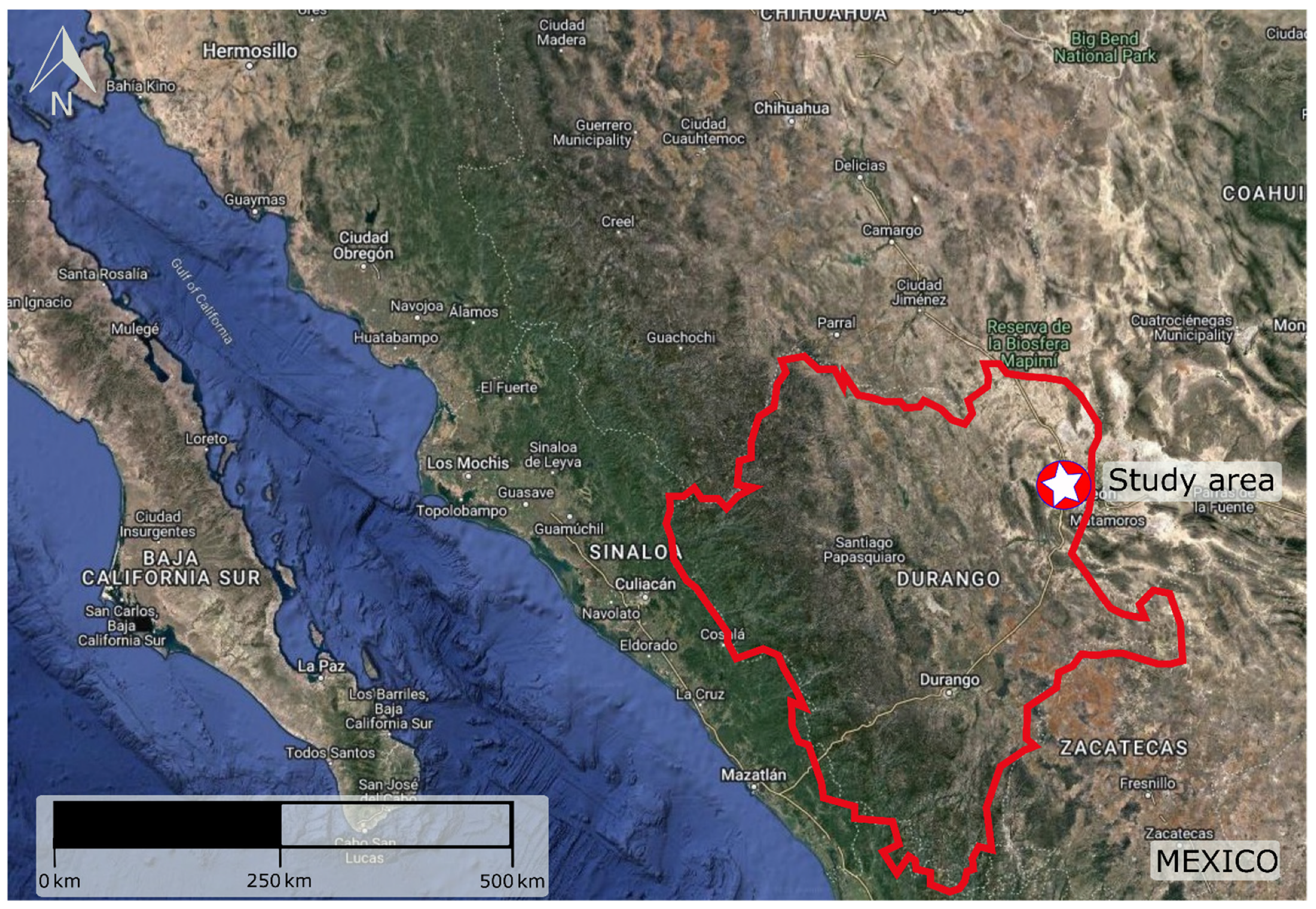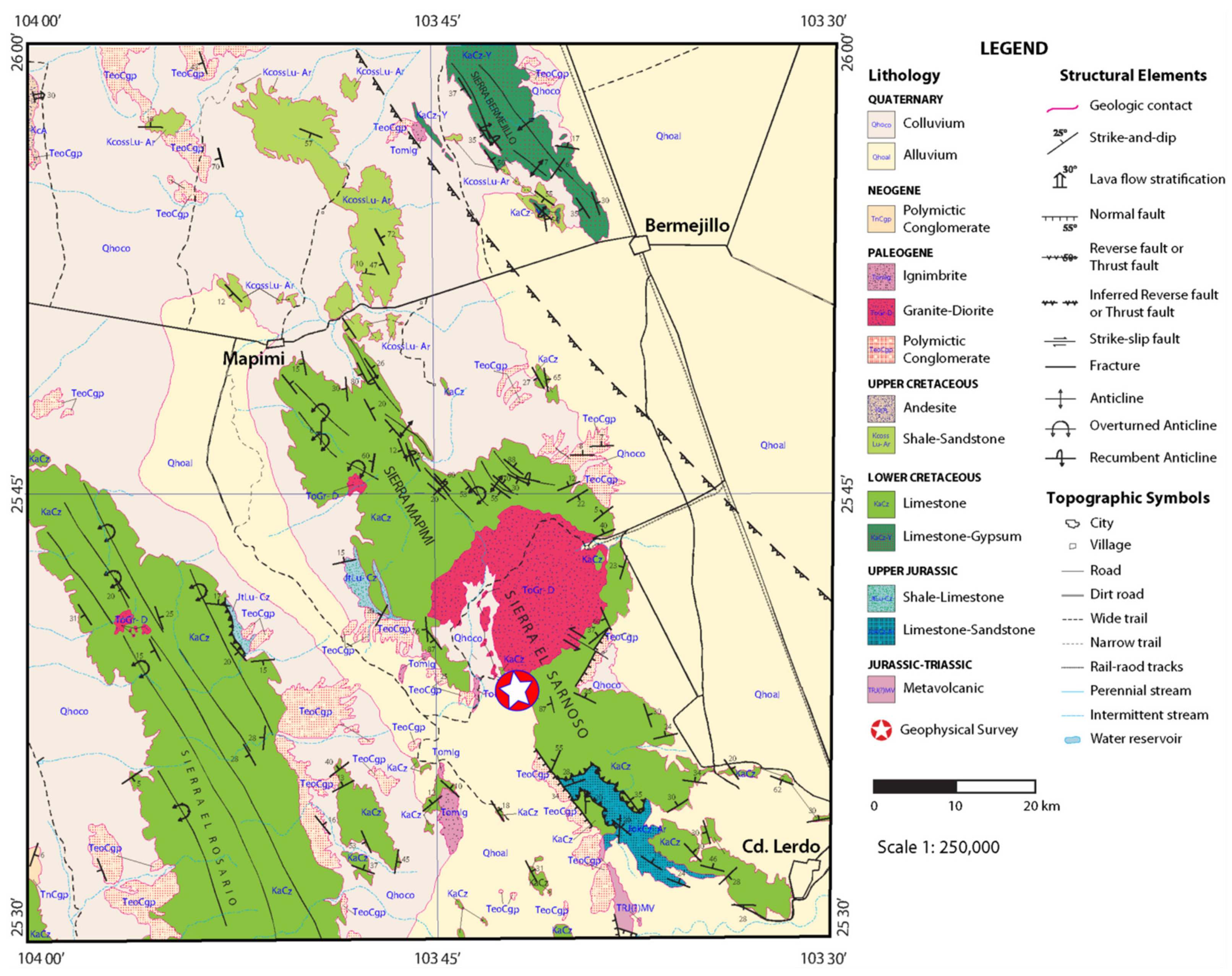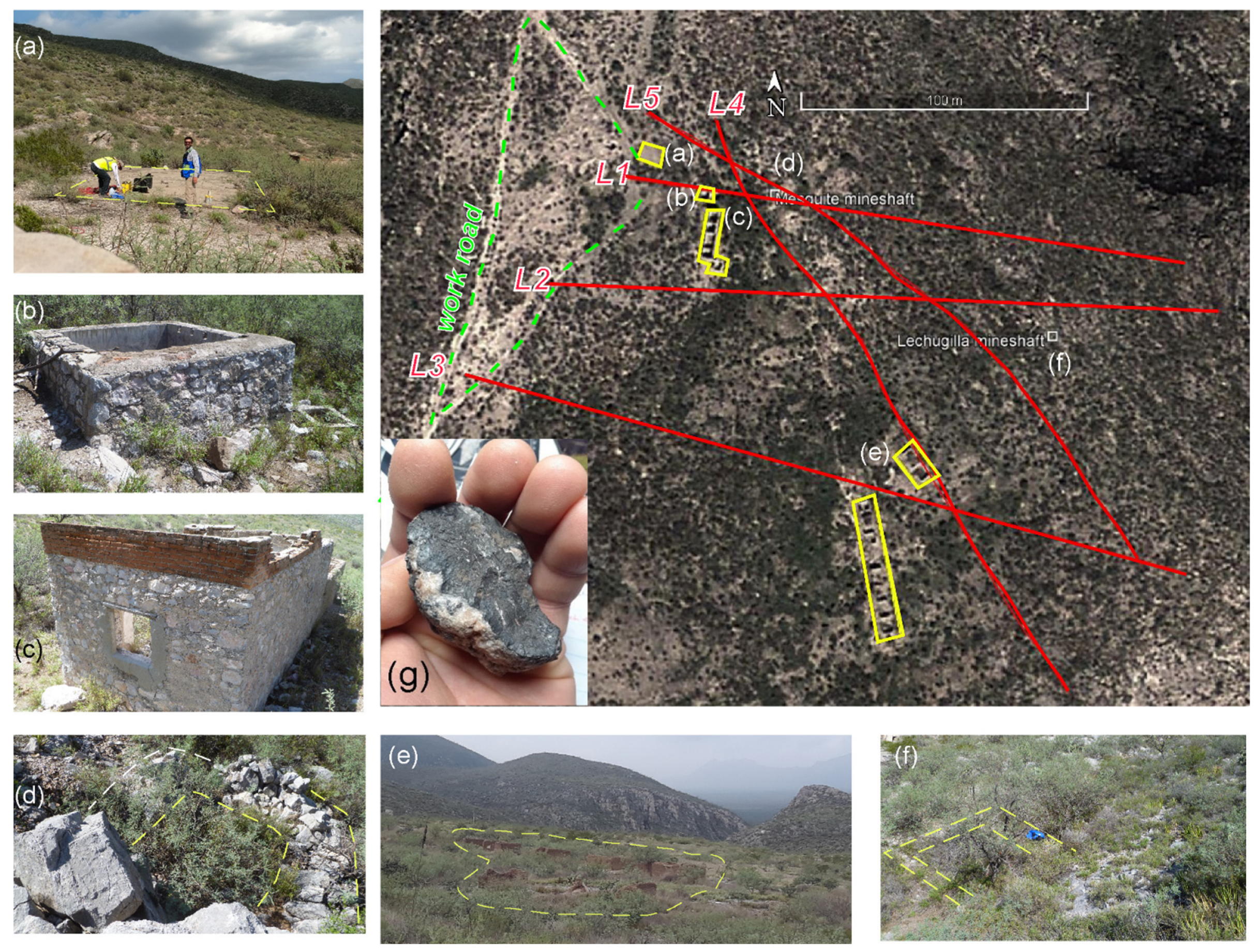Historic Underground Silver Mine Workings Detection Using 2D Electrical Resistivity Imaging (Durango, Mexico)
Abstract
:1. Introduction
2. Study Area
2.1. Local Geology
2.2. Field Observations
3. Electrical Resistivity Imaging Survey
3.1. Data Acquisition
3.2. Data Processing and Inversion
4. Results and Interpretation
4.1. Profile L1
4.2. Profile L2
4.3. Profile L3
4.4. Profile L4
4.5. Profile L5
5. Discussion
6. Conclusions
Author Contributions
Funding
Institutional Review Board Statement
Informed Consent Statement
Data Availability Statement
Acknowledgments
Conflicts of Interest
References
- Cheng, H.J.; Chen, C.; Zhan, X.Z.; Chang, J.Y.; Ding, Y.L.; Kuwanixibieke, M.; Yang, R.H.; Jia, N.E.; Fu, H.Z. New progress in the prediction theory and prospecting method for concealed deposits. Geol. Explor. 2017, 53, 456–463. [Google Scholar]
- Fu, J.; Jia, S.; Wang, E. Combined Magnetic, Transient Electromagnetic, and Magnetotelluric Methods to Detect a BIF-Type Concealed Iron Ore Body: A Case Study in Gongchangling Iron Ore Concentration Area, Southern Liaoning Province, China. Minerals 2020, 10, 1044. [Google Scholar] [CrossRef]
- Alfouzan, F.A.; Alotaibi, A.M.; Cox, L.H.; Zhdanov, M.S. Spectral Induced Polarization Survey with Distributed Array System for Mineral Exploration: Case Study in Saudi Arabia. Minerals 2020, 10, 769. [Google Scholar] [CrossRef]
- Jorgensen, M.; Zhdanov, M. Recovering Magnetization of Rock Formations by Jointly Inverting Airborne Gravity Gradiometry and Total Magnetic Intensity Data. Minerals 2021, 11, 366. [Google Scholar] [CrossRef]
- Ihbach, F.-Z.; Kchikach, A.; Jaffal, M.; El Azzab, D.; Khadiri Yazami, O.; Jourani, E.-S.; Peña Ruano, J.A.; Olaiz, O.A.; Dávila, L.V. Geophysical Prospecting for Groundwater Resources in Phosphate Deposits (Morocco). Minerals 2020, 10, 842. [Google Scholar] [CrossRef]
- Stevens, R. Mineral Exploration and Mining Essentials; Pakawau Geomanagement Inc.: Vancouver, BC, Canada, 2011; ISBN 978-0-9867221-0-3. [Google Scholar]
- Loke, M.H.; Chambers, J.E.; Rucker, D.F.; Kuras, O.; Wilkinson, P.B. Recent developments in the direct-current geoelectrical imaging method. J. Appl. Geophys. 2013, 95, 135–156. [Google Scholar] [CrossRef]
- Binley, A.; Kemna, A. DC Resistivity and Induced Polarization Methods. In Hydrogeophysics; Springer: Dordrecht, The Netherlands, 2005; pp. 129–156. [Google Scholar]
- Simyrdanis, K.; Papadopoulos, N.; Soupios, P.; Kirkou, S.; Tsourlos, P. Characterization and monitoring of subsurface contamination from Olive Oil Mills’ waste waters using Electrical Resistivity Tomography. Sci. Total Environ. 2018, 637–638, 991–1003. [Google Scholar] [CrossRef]
- Edigbue, P.I.; Al-Mashhor, A.A.; Plougarlis, A.; Soupios, P.; Tranos, M.; Kaka, S.; Al-Shuhail, A.; Al-Garni, M. Geological and geophysical investigations of an engineering site characterization for construction purposes in Western Saudi Arabia. J. Appl. Geophys. 2021, 188, 104307. [Google Scholar] [CrossRef]
- McAnallen, L.; Doherty, R.; Donohue, S.; Kirmizakis, P.; Mendonça, C. Combined use of geophysical and geochemical methods to assess areas of active, degrading and restored blanket bog. Sci. Total Environ. 2018, 621, 762–771. [Google Scholar] [CrossRef] [Green Version]
- Kirmizakis, P.; Kalderis, D.; Ntarlagiannis, D.; Soupios, P. Preliminary assessment on the application of biochar and spectral-induced polarization for wastewater treatment. Near Surf. Geophys. 2020, 18, 109–122. [Google Scholar] [CrossRef]
- Siddiq, M.O.; Tawabini, B.; Kirmizakis, P.; Kalderis, D.; Ntarlagiannis, D.; Soupios, P. Combining geophysics and material science for environmental remediation: Real-time monitoring of Fe-biochar arsenic wastewater treatment. Chemosphere 2021, 284, 131390. [Google Scholar] [CrossRef] [PubMed]
- Power, C.; Gerhard, J.I.; Tsourlos, P.; Soupios, P.; Simyrdanis, K.; Karaoulis, M. Improved time-lapse electrical resistivity tomography monitoring of dense non-aqueous phase liquids with surface-to-horizontal borehole arrays. J. Appl. Geophys. 2015, 112, 1–13. [Google Scholar] [CrossRef]
- Ntarlagiannis, D.; Robinson, J.; Soupios, P.; Slater, L. Field-scale electrical geophysics over an olive oil mill waste deposition site: Evaluating the information content of resistivity versus induced polarization (IP) images for delineating the spatial extent of organic contamination. J. Appl. Geophys. 2016, 135, 418–426. [Google Scholar] [CrossRef]
- Demirci, İ.; Candansayar, M.E.; Vafidis, A.; Soupios, P. Two dimensional joint inversion of direct current resistivity, radio-magnetotelluric and seismic refraction data: An application from Bafra Plain, Turkey. J. Appl. Geophys. 2017, 139, 316–330. [Google Scholar] [CrossRef]
- Telford, W.M.; Geldart, L.P.; Sheriff, R.E. Applied Geophysics, 2nd ed.; Cambridge University Press: Cambridge, UK, 1990; ISBN 0-521-32693-1. [Google Scholar]
- Sağır, Ç.; Kurtuluş, B.; Soupios, P.; Ayrancı, K.; Düztaş, E.; Aksoy, M.E.; Avşar, Ö.; Erdem, G.; Pekkan, E.; Canoğlu, M.C.; et al. Investigating the Structure of a Coastal Karstic Aquifer through the Hydrogeological Characterization of Springs Using Geophysical Methods and Field Investigation, Gökova Bay, SW Turkey. Water 2020, 12, 3343. [Google Scholar] [CrossRef]
- Demirci, İ.; Gündoğdu, N.Y.; Candansayar, M.E.; Soupios, P.; Vafidis, A.; Arslan, H. Determination and Evaluation of Saltwater Intrusion on Bafra Plain: Joint Interpretation of Geophysical, Hydrogeological and Hydrochemical Data. Pure Appl. Geophys. 2020, 177, 5621–5640. [Google Scholar] [CrossRef]
- Zhdanov, M.; Endo, M.; Cox, L.; Sunwall, D. Effective-Medium Inversion of Induced Polarization Data for Mineral Exploration and Mineral Discrimination: Case Study for the Copper Deposit in Mongolia. Minerals 2018, 8, 68. [Google Scholar] [CrossRef] [Green Version]
- Oldenburg, D.W.; Li, Y.; Farquharson, C.G.; Kowalczyk, P.; Aravanis, T.; King, A.; Zhang, P.; Watts, A. Applications of geophysical inversions in mineral exploration. Lead. Edge 1998, 17, 461–465. [Google Scholar] [CrossRef] [Green Version]
- Saad, R.; Adli, I.; Mohamad, A.S. The study of iron ore prospect using 2-D resistivity and induced polarization (IP) method. Electron. J. Geotech. Eng. 2012, 17, 2981–2988. [Google Scholar]
- Griffiths, D.H.; Barker, R.D. Electrical Imaging in Archaeology. J. Archaeol. Sci. 1994, 21, 153–158. [Google Scholar] [CrossRef]
- Krishnamurthy, N.S.; Ananda Rao, V.; Kumar, D.; Singh, K.K.K.; Ahmed, S. Electrical Resistivity Imaging technique to delineate coal seam barrier thickness and demarcate water-filled voids. J. Geol. Soc. India 2009, 73, 639–650. [Google Scholar] [CrossRef]
- Das, P.; Pal, S.K.; Mohanty, P.R.; Priyam, P.; Bharti, A.K.; Kumar, R. Abandoned mine galleries detection using electrical resistivity tomography method over Jharia coal field, India. J. Geol. Soc. India 2017, 90, 169–174. [Google Scholar] [CrossRef]
- González-Sánchez, F.; Camprubí, A. La pequeña minería en México. Boletín La Soc. Geológica Mex. 2010, 62, 101–108. [Google Scholar] [CrossRef]
- Studnicki-Gizbert, D.; Schecter, D. The Environmental Dynamics of a Colonial Fuel-Rush: Silver Mining and Deforestation in New Spain, 1522 to 1810. Environ. Hist. Durh. N. C. 2010, 15, 94–119. [Google Scholar] [CrossRef] [Green Version]
- Moore, T.P. A brief history of early: Silver mining in Spanish America. Mineral. Rec. 2008, 39, 5–21. [Google Scholar]
- Servicio Geológico Mexicano (SGM). Panorama Minero del Estado de Durango; Servicio Gelogico Mexicano (Mexican Geological Survey): Pachuca, Mexico, 2020; pp. 1–65. [Google Scholar]
- Young, O.E. The Spanish Tradition in Gold and Silver Mining. J. Southwest Req. Permis. 1965, 7, 299–314. [Google Scholar]
- Pletcher, D.M. The Fall of Silver in Mexico, 1870–1910, and Its Effect on American Investments. J. Econ. Hist. 1958, 18, 33–55. [Google Scholar] [CrossRef]
- Barton, M.D.; Staude, J.-M.G.; Megaw, P.K.M. Porphyry Copper and Other Intrusion-Related Mineralization in Mexico. Arizona Geol. Soc. Dig. 1995, 20, 487–524. [Google Scholar]
- Camprubí, A. The metallogenic evolution in Mexico during the Mesozoic, and its bearing in the Cordillera of Western North America. Ore Geol. Rev. 2017, 81, 1193–1214. [Google Scholar] [CrossRef]
- Servicio Geológico Mexicano (SGM). Carta Geológico-Minera Torreón G13-9 (Scale1:250,000); Servicio Gelogico Mexicano (Mexican Geological Survey): Pachuca, Mexico, 2000. [Google Scholar]
- Tristán-González, M.; Aguirre-Díaz, G.J.; Labarthe-Hernández, G.; Torres-Hernández, J.R.; Bellon, H. Post-Laramide and pre-Basin and Range deformation and implications for Paleogene (55–25 Ma) volcanism in central Mexico: A geological basis for a volcano-tectonic stress model. Tectonophysics 2009, 471, 136–152. [Google Scholar] [CrossRef]
- Ortega-Gutiérrez, F.; Elías-Herrera, M.; Morán-Zenteno, D.J.; Solari, L.; Luna-González, L.; Schaaf, P. A review of batholiths and other plutonic intrusions of Mexico. Gondwana Res. 2014, 26, 834–868. [Google Scholar] [CrossRef]
- Neyamadpour, A.; Wan Abdullah, W.A.T.; Taib, S.; Neyamadpour, B. Comparison of Wenner and dipole–dipole arrays in the study of an underground three-dimensional cavity. J. Geophys. Eng. 2010, 7, 30–40. [Google Scholar] [CrossRef]
- Zarif, F.; Kessouri, P.; Slater, L. Recommendations for Field-Scale Induced Polarization (IP) Data Acquisition and Interpretation. J. Environ. Eng. Geophys. 2017, 22, 395–410. [Google Scholar] [CrossRef]
- Gündoğdu, N.Y.; Demirci, İ.; Özyildirim, Ö.; Aktarakçi, H.; Candansayar, M.E. Investigating the Use of Stainless Steel Electrodes with the IP Method: A Metallic Ore Deposit Example. Pure Appl. Geophys. 2022, 179, 265–274. [Google Scholar] [CrossRef]
- Malo-Lalande, C.; Desbiens, R.; Roger, S. Getting a better control of IP acquisitions with GDD’s new IP Post-Processing software. ASEG Ext. Abstr. 2018, 2018, 1–4. [Google Scholar] [CrossRef] [Green Version]
- John, P.; Copeland, A. Reduction of Noise in Induced Polarization Data using Full Time-Series Data. Explor. Geophys. 2003, 34, 225–228. [Google Scholar] [CrossRef]
- Bérubé, C.L.; Bérubé, P. Data-driven modeling of time-domain induced polarization. Geophysics 2022, 87, 135–146. [Google Scholar] [CrossRef]





| Parameter | L1 | L2 | L3 | L4 | L5 |
|---|---|---|---|---|---|
| Electrodes used | 42 | 52 | 50 | 48 | 50 |
| Profile length (m) | 205 | 255 | 245 | 235 | 245 |
| Terrain file and Y-offset | Acquired | Acquired | Acquired | Acquired | Acquired |
| Data acquired | ERI/IP | ERI/IP | ERI | ERI/IP | ERI |
| Profile | RMS % | L2-Norm | Iteration Number | Quality Factor | ||
|---|---|---|---|---|---|---|
| Yes/No | Value | Yes/No | Value | |||
| L1 | No | 7.68 a | Yes | 0.87 a | 8 | Excellent |
| No | 6.24 b | Yes | 4.32 b | 8 | ||
| No | 6.87 c | Yes | 0.81 c | 8 | ||
| L2 | Yes | 7.01 a | Yes | 1.96 a | 8 | Excellent |
| No | 5.48 b | Yes | 1.20 b | 8 | ||
| Yes | 6.32 c | No | 1.6 c | 7 | ||
| L3 | Yes | 6.11 a | No | 4.01 a | 8 | Good |
| Yes | 6.70 b | Yes | 4.85 b | 8 | ||
| Yes | 6.80 c | No | 5.01 c | 8 | ||
| L4 | Yes | 5.40 a | No | 3.24 a | 8 | Excellent |
| Yes | 3.80 b | No | 1.58 b | 8 | ||
| Yes | 3.81 c | No | 1.58 c | 8 | ||
| L5 | Yes | 9.34 a | No | 9.65 a | 8 | Good |
| Yes | 10.94 b | No | 13.29 b | 8 | ||
| Yes | 7.34 c | No | 5.99 c | 8 | ||
Publisher’s Note: MDPI stays neutral with regard to jurisdictional claims in published maps and institutional affiliations. |
© 2022 by the authors. Licensee MDPI, Basel, Switzerland. This article is an open access article distributed under the terms and conditions of the Creative Commons Attribution (CC BY) license (https://creativecommons.org/licenses/by/4.0/).
Share and Cite
Hinojosa, H.R.; Kirmizakis, P.; Soupios, P. Historic Underground Silver Mine Workings Detection Using 2D Electrical Resistivity Imaging (Durango, Mexico). Minerals 2022, 12, 491. https://doi.org/10.3390/min12040491
Hinojosa HR, Kirmizakis P, Soupios P. Historic Underground Silver Mine Workings Detection Using 2D Electrical Resistivity Imaging (Durango, Mexico). Minerals. 2022; 12(4):491. https://doi.org/10.3390/min12040491
Chicago/Turabian StyleHinojosa, Hector R., Panagiotis Kirmizakis, and Pantelis Soupios. 2022. "Historic Underground Silver Mine Workings Detection Using 2D Electrical Resistivity Imaging (Durango, Mexico)" Minerals 12, no. 4: 491. https://doi.org/10.3390/min12040491








